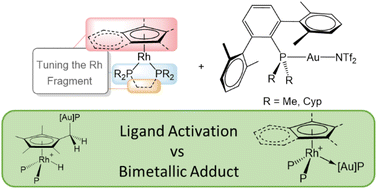Polarized Au(i)/Rh(i) bimetallic pairs cooperatively trigger ligand non-innocence and bond activation†
Abstract
The combination of molecular metallic fragments of contrasting Lewis character offers many possibilities for cooperative bond activation and for the disclosure of unusual reactivity. Here we provide a systematic investigation on the partnership of Lewis basic Rh(I) compounds of type [(η5-L)Rh(PR3)2] (η5-L = (C5Me5)− or (C9H7)−) with highly congested Lewis acidic Au(I) species. For the cyclopentadienyl Rh(I) compounds, we demonstrate the non-innocent role of the typically robust (C5Me5)− ligand through migration of a hydride to the Rh site and provide evidence for the direct implication of the gold fragment in this unusual bimetallic ligand activation event. This process competes with the formation of dinuclear Lewis adducts defined by a dative Rh → Au bond, with selectivity being under kinetic control and tunable by modifying the stereoelectronic and chelating properties of the phosphine ligands bound to the two metals. We provide a thorough computational study on the unusual Cp* non-innocent behavior and the divergent bimetallic pathways observed. The cooperative FLP-type reactivity of all bimetallic pairs has been investigated and computationally examined for the case of N–H bond activation in ammonia.



 Please wait while we load your content...
Please wait while we load your content...